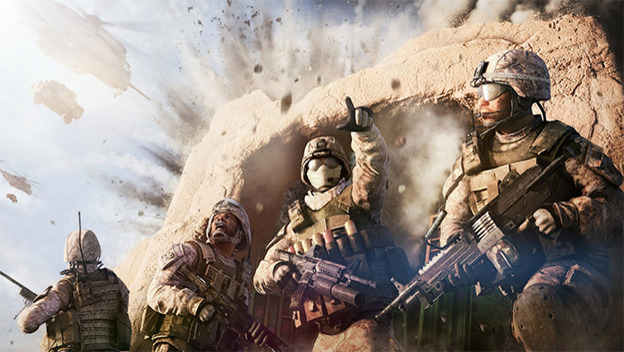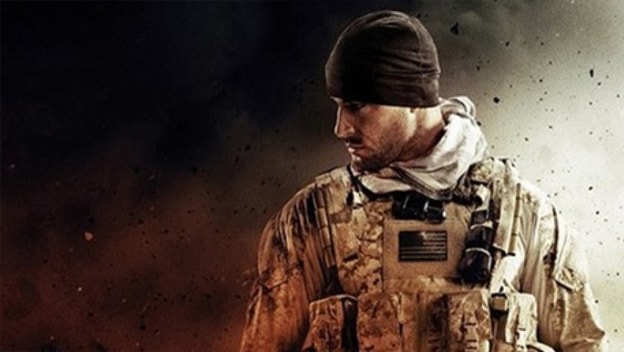We hit full-on Call of Duty fever a couple of weeks ago, the release of Black Ops II spawned lines in the parking lots of GameStops across the country and critical acclaim seemingly across the board. Cheat Code Central’s own Josh Engen gave it his seal of approval . The changes and additions made to its formula appeal to me, and Josh Wirtanen has expressed unrestrained glee at its multiplayer maps .
Black Ops II isn’t the only shooter out this year, though. Hell, it’s not even the only military shooter to come out this fall. No, earlier in our fine autumn, we were graced with the presence of another, an effort from Activision’s longstanding rival publisher, Electronic Arts, which attempted to leverage the age-old name of Medal of Honor—the series that effectively spawned Call of Duty, if you trudge back through history to Infinity Ward’s formation—and Battlefield 3’s Frostbite 2 technology in a one-two punch via Medal of Honor: Warfighter.
The hope, it seemed, was to remove the less-than-satisfactory taste of 2010’s entry from gamers’ palettes, grabbing some market share out from under Activision and its Call of Duty behemoth. Or, more likely given the quality of Warfighter’s retail product , it was meant to cash in on that other series’ popularity, striking sooner and providing a somewhat similar experience. Nominally, it does, but that impression doesn’t hold up past the first hour or two one spends with the title. The question is, of course, why? What went wrong that made Warfighter such an abject failure of a big-budget, highly publicized game?
This title was shown at E3, with its own enclosed presentation room in EA’s massive booth, along with an array of demo units in said booth’s main hub, taking up a significant amount of floor space. Then, close to release, there was a preview event for the title in San Francisco, during which I was exposed to a small helping of its multiplayer content and a pair of early campaign missions. It seemed as though this was one of those “big” EA titles that are destined to be big sellers by virtue of confidence alone. The illusion of confidence was soon shattered when review copies of the game weren’t sent out until release day itself. That’s perhaps more understandable when you take into account that my hands-on time with that demo build was affected by a not-insignificant smattering of glitches.
At that same event, I also met Luke Thai. Luke was one of the game’s single-player producers. He conducted a presentation before we even touched the campaign and was available for interviews, so I sat down with him.
One of the first things we talked about what Medal of Honor’s history, during which Luke asserted that this newest game was as beholden to the tradition of authenticity as its predecessors, that “every single facet” of the game had been affected by the team’s collaboration with real operatives. This resulted in some “ripped from the headlines” moments for EA, but seems to have backfired on the members of SEAL Team Six who served as consultants for the title, their conduct having been deemed improper for their station . This echoes, in a way, the controversy that surrounded 2010’s Medal of Honor before it came to stores, when it still featured the Taliban as a playable multiplayer faction; even after their removal, stores on military bases still refused to carry it.
And the fact of the matter is, those “authentic moments” don’t feel authentic; they feels staged and stilted, which may have to do with the very next thing Luke told me: that they were breaking from tradition in this game and basing it on multiple real operations instead of just one. The issue is, when going for authenticity, simply taking a few real events and mashing them together with discount plot glue and a barely-present story about the tensions in military families and the prices they pay doesn’t make the entire experience feel authentic. Instead, it just feels disjointed where it should be cohesive, and the action ceases to satisfy.
Part of this is a lack of stimulation. While Call of Duty and Medal of Honor: Warfighter are both military-themed shooters, which largely contain similar basic mechanics, Call of Duty games tend to either wrap their core action around a persistent supply of high-octane set-pieces or construct a dark, winding narrative that intrigues and deepens one’s connection to the game. We’ve already established that Warfighter lacked a solid narrative, but its scale was also lacking. Yes, this is the distinction between authenticity and bombast, but that bombast is exceptionally dramatic and the authenticity isn’t.
I asked Luke Thai about what Warfighter was doing regarding a measure like Call of Duty’s set pieces and he assured me that, while there wasn’t a propensity of stuff on that scale, there would be smaller moments in every level that made them stand out. Sitting here now, I remember the robot, which was practically on rails, and a pair of driving sequences. Only the second one, with its stealth mechanics (yes, a stealth car sequence) was really interesting.

Another part of the story woes, though, was the lack of a clear and compelling villain. “The Cleric” is mentioned a few times, and seen just as rarely, and we’re told of the constant threat of PETN (which, given its extremely volatile nature, you’d think would lead to some impressive explosions in the game, outside of the very first introductory level), but we don’t really get a sense of their importance, much less their viability as global security threats. More intimidating than “The Cleric,” who seems like a pencil-pushing schmo playing terrorist dress-up to combat his social insecurities, is his bodyguard. Again, you’ll only see him two or three times, but at least he gives you a reason to hate him and want to see him beaten to a pulp.
Warfighter under-delivered on plot, it under-delivered on spectacle, and it under-delivered on a technical level, too. Single-player had glitches that could outright stop the game if one’s A.I. teammates didn’t trigger correctly, while its multiplayer is full of uninteresting and claustrophobic levels. It doesn’t help that nothing can really be destroyed in them.
That was one of the big draws of Warfighter, after all. It had switched over to the Frostbite 2 engine, which, while known for looking absolutely gorgeous, is better known for facilitating the sort of destruction seen in Battlefield 3. We’re talking “reshaping an urban landscape” level of malleability here. Medal of Honor: Warfighter’s take? Some wooden barriers can be destroyed or fired through. Most can’t. Figure out which ones on your own.
The potential really was there. Frostbite 2 is a superb engine and, from talking to Luke, it sounded like Danger Close had a handle on creating a tight and compelling meditation on war and the unsung human cost thereof, in emotions rather than in body count. The core shooting action is satisfying, but isn’t carried by anything compelling enough to justify it due to what is the result of either too little development time, a machete taken to the plot to bring it more in line with what is expected by Joe Average Gamer, or a lack of the editorial and creative chops necessary to match up to what appears to have been tremendous ambition.
 | By Shelby Reiches Lead Contributor Date: November 28, 2012 |
